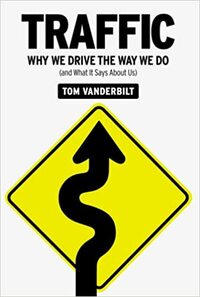Take a photo of a barcode or cover
Kinda bizarre listening to a book about traffic while driving in traffic. I added this to my to-read list when Malcolm Gladwell suggested it in his podcast. I can so totally see Malcolm Gladwell getting into this book. At the time it was the only book available on Overdrive. It is a very thorough examination of traffic and the psychology behind it. I get that late merging is the best use of traffic lanes, but it still seams rude to me. Also, I still really dislike roundabouts, but they far and away outperform intersections. Also, I don't think I'll ever put a self-identifying bumper sticker or decal on my car again and I'm currently chockablock full of traffic trivia!
I bought this book so long ago that some of it is a bit dated, I mean there was even a Blockbuster Video reference in there! However, the basics regarding human nature and why we drive like we do haven't changed. It was full of lots of interesting pieces of information and had made me view driving with a slightly different perspective. It's not so dated though that it isn't aware of self-driving cars and what kind of impact that could have.
Not only SHOULD every driver read this, but you will also WANT to!...At least the first four chapters. They are incredibly informing and revealing about our self-deceptions as drivers on the road. I had a complete paradigm shift. The last 5 chapters are more psychological/research-related, and felt a little dry at times for a layman driver. If I could, I would have Vanderbilt republish the first four chapters and maybe a short summary of the other 5 for the sake of interest, and make this condensed version more distributable so we can save more lives on the road and drive smarter.
For example, did you know that the safer a road is perceived to be, the more dangerous it actually is because of a driver's attitude toward his/her own safety? The same goes with the perceived safety of a car-most accidents happen in brand new cars.
Check this out from your local library and at least read Chapters 1-4. It might save your life. I'm not exaggerating.
For example, did you know that the safer a road is perceived to be, the more dangerous it actually is because of a driver's attitude toward his/her own safety? The same goes with the perceived safety of a car-most accidents happen in brand new cars.
Check this out from your local library and at least read Chapters 1-4. It might save your life. I'm not exaggerating.
funny and thought-provoking exploration of human behavior as it applies to driving
Fantastic: this book should be required reading for everyone who drives, bicycles, or walks anywhere near the road. I could not seem to finish a page without turning to wife and bothering with her with some fascinating new piece of information about traffic flow, risky driving behaviors, safety strategies, etc. Unlike some reviewers who found the book to be scary, I found it not to be frightening, but rather enlightening (no poem intended).
I grew up in Los Angeles, so this book may have been particularly meaningful for my own experience. After all, I learned to drive before I could walk. And I will readily admit to the fact that I am the best driver in the world, and that at least half of the other drivers [b:on the road|6288|The Road|Cormac McCarthy|http://ecx.images-amazon.com/images/I/21E8H3D1JSL._SL75_.jpg|3355573] have no business behind the wheel of anything larger than a unicycle. This, of course, made it that much more interesting for me to read about how all drivers have a self-bias, and how the individual driver's self-centeredness often trumps the greater good of overall traffic flow. It is this sort of revelation not just about the driving habits of others but also of my own driving tendencies and their consequences that made this book so impressive.
Vanderbilt's book is not just focused, however, at individual driving trends. One of my favorite parts of his book is his handling of traffic engineering. For example, who would have thought that roundabouts are actually safer than traffic lights while also increasing overall traffic flow? One of my favorites is the story of one town (I think it was Dutch, but I'm not positive) that wanted to lower traffic speeds of people entering the town from the highway. Instead of putting up a whole bunch of signs and speed bumps, the traffic engineer actually did away with signs, instead narrowing the road and doing away with sidewalks to give drivers the impression they were driving through a small village and relying on human mental reactions to lower speed accordingly.
All of these lessons are delivered with good humor by a writer who was clearly as fascinated to learn these things during the course of his research as the reader is while reading the book. I was particularly struck by the description of speed bumps in Mexico City, which I visited about two months ago: "The ferocity of Mexico City traffic is revealed by the topes, or speed bumps, that are scattered throughout the capital like the mysterious earthen mounds of an ancient civilization. Mexico City's speed bumps may be the largest in the world . . . . Woe to the driver who hits one at anything but the most glacial creep."
The combination of good writing and in-depth, startlingly educational coverage of so important a topic has me recommending this book to everyone I talk to these days (and my friends and family should not be surprised if they receive it as a present this holiday season).
I grew up in Los Angeles, so this book may have been particularly meaningful for my own experience. After all, I learned to drive before I could walk. And I will readily admit to the fact that I am the best driver in the world, and that at least half of the other drivers [b:on the road|6288|The Road|Cormac McCarthy|http://ecx.images-amazon.com/images/I/21E8H3D1JSL._SL75_.jpg|3355573] have no business behind the wheel of anything larger than a unicycle. This, of course, made it that much more interesting for me to read about how all drivers have a self-bias, and how the individual driver's self-centeredness often trumps the greater good of overall traffic flow. It is this sort of revelation not just about the driving habits of others but also of my own driving tendencies and their consequences that made this book so impressive.
Vanderbilt's book is not just focused, however, at individual driving trends. One of my favorite parts of his book is his handling of traffic engineering. For example, who would have thought that roundabouts are actually safer than traffic lights while also increasing overall traffic flow? One of my favorites is the story of one town (I think it was Dutch, but I'm not positive) that wanted to lower traffic speeds of people entering the town from the highway. Instead of putting up a whole bunch of signs and speed bumps, the traffic engineer actually did away with signs, instead narrowing the road and doing away with sidewalks to give drivers the impression they were driving through a small village and relying on human mental reactions to lower speed accordingly.
All of these lessons are delivered with good humor by a writer who was clearly as fascinated to learn these things during the course of his research as the reader is while reading the book. I was particularly struck by the description of speed bumps in Mexico City, which I visited about two months ago: "The ferocity of Mexico City traffic is revealed by the topes, or speed bumps, that are scattered throughout the capital like the mysterious earthen mounds of an ancient civilization. Mexico City's speed bumps may be the largest in the world . . . . Woe to the driver who hits one at anything but the most glacial creep."
The combination of good writing and in-depth, startlingly educational coverage of so important a topic has me recommending this book to everyone I talk to these days (and my friends and family should not be surprised if they receive it as a present this holiday season).
Have about 75 pages left and I just can't do anymore. It was good for a little while, but it's gone on too long.
The good: I know have a good number of interesting facts for parties.
The bad: it can get kind of dry at times. I wish it had diagrams and images at times to illustrate the points and examples.
Overall, interesting read but one that needs a little commitment.
The bad: it can get kind of dry at times. I wish it had diagrams and images at times to illustrate the points and examples.
Overall, interesting read but one that needs a little commitment.
Entertaining and fascinating but also too long and sometimes too tedious.
A mostly interesting look at traffic: the psychology, the risks, the causes and various solutions, the trends in both first and third world countries, and more. My favorite parts were the psych studies that shed light on driver behavior; least favorite bits were when the author got a little statistic heavy (or focused more on the act of driving, rather then the collective thing known as traffic). Overall, enjoyable and learned a lot (mostly, that I need to stop driving!).




